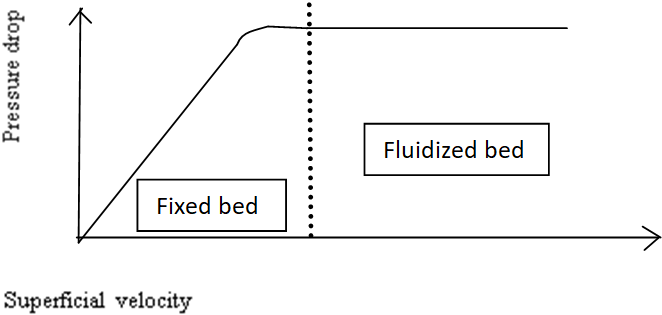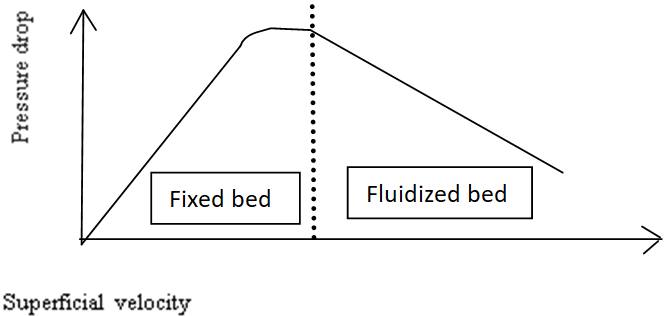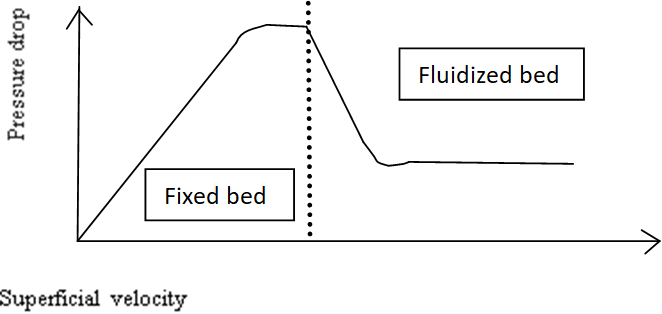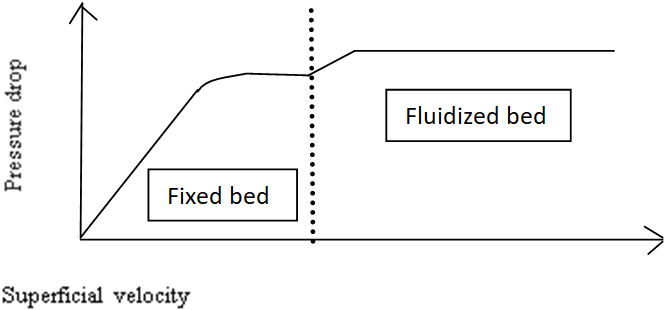This set of Mechanical Operations Multiple Choice Questions & Answers (MCQs) focuses on “Characteristics of Fluidized System”.
1. Which of the following liquid like properties is correct about fluidized beds?
a) Heavier particles float on the top
b) Have a non-static pressure head
c) Assume the shape of the container that contains it
d) Non zero angle of repose
View Answer
Explanation: Due to the action of gravity, fluidized beds have a static pressure head. They have a zero angle of repose. Lighter particles float on the top due to lesser density while the heavier particles stay underneath.
2. Which of the following graphs best describe the relation between the pressure drop and superficial velocity in fixed and fluidized beds
a)

b)

c)

d)

View Answer
Explanation: In a fixed bed, as the velocity increases the pressure drop increases however, the bed particles do not move and the bed height remains constant. Eventually there comes a point, when the drag and weight of particles become equal and fluidization occurs. The velocity at which this takes place, is the coordinate where the dotted line meets the x axis. The pressure drop then remains constant.
3. Which of the following is not a correct characteristic of Fluidized system?
a) Liquid like behavior
b) Cannot resist temperature change
c) Easy control
d) Rapid mixing is also possible
View Answer
Explanation: Fluidized beds can resist temperature change. This is why resist any changes in operating conditions. Thermal runaway is a condition when an increase in temperature changes the operating conditions and results in a destructive circumstance. Fluidized beds also resist any such thermal runaway.
4. Fluidized beds cannot be used as dryers.
a) True
b) False
View Answer
Explanation: Fluidized beds can also be used as dryers and for heat treatment. However, their design differs from that of the usual fluidized beds. For instance, the bed height in this case is between 0.3 m and 0.5 m unlike typical fluidized beds where the bed height is between 1 m and 10 m.
5. Which of the following is true about gas distribution in fluidized beds?
a) Proper gas distribution is independent of the orifice diameters
b) Low grid pressure drop ensures uniform gas distribution
c) Particle weeping can be limited by keeping the pressure drop over orifices above a particular minimum value
d) Ideal pressure drop across a grid plate should be lesser than 4,500 Pa
View Answer
Explanation: The number of orifices and their diameter greatly affect the gas distribution in a fluidized bed. In case of low grid pressure drop, bed hydrodynamics regulate the gas flow and the gas is distributed unevenly. Ideal pressure drop across a grid plate is usually lesser than 2,500 Pa.
6. Crush strength of a particle is an indication of the particle’s attrition properties which are necessary to study attrition and erosion of the fluidized bed.
a) True
b) False
View Answer
Explanation: Crush strength is not indicative of the attrition property of particles. It is rather static and used for packed bed applications and not fluidized bed applications. Attrition is caused by dynamic forces, therefore can be tested by ball mill testing, jet mill testing, etc. A study of attrition gives us data on the erosion of the bed as well.
7. Which of the following characteristic part of a fluidized system is not needed in every system designed?
a) Particle bed region
b) A gas distributor
c) Plenum
d) Heating and cooling coils
View Answer
Explanation: Heating and cooling coils are preferably required when fluidized beds are associated with heat, i.e.: either an exothermic or an endothermic reaction takes place. These coils are not required in case a major temperature change does not take place.
8. Which of the following is the correct equation for pressure drop over orifices when the bed height is greater than 0.3 m?
a) ΔPorifice ≤ \(\frac {1}{3}\) Hbed × \(\frac {g}{gc}\) × ρbulk
b) ΔPorifice ≤ \(\frac {2}{3}\) Hbed × \(\frac {g}{gc}\) × ρbulk
c) ΔPorifice ≥ \(\frac {1}{3}\) Hbed × \(\frac {g}{gc}\) × ρbulk
d) ΔPorifice ≥ \(\frac {2}{3}\) Hbed × \(\frac {g}{gc}\) × ρbulk
View Answer
Explanation: The pressure drop over each orifice in a distributor is dependent on the bed height. When the bed height is greater than 0.3 m, the bed is considered relatively tall and the pressure drop over the orifices is given by ΔPorifice ≥ \(\frac {1}{3}\) Hbed × \(\frac {g}{gc}\) × ρbulk. Here, Hbed is the height of the bed in meters, gc is the force-weight conversion factor and ρbulk is the bulk density in kg/m3.
9. Which of the following is not a cause of particle attrition in fluidized beds?
a) When gas jets are placed far
b) When gas jets leaving the distributor intersect
c) High velocity jets cause particles to collide
d) When particle carried by swishing gas flow collide
View Answer
Explanation: When gas jets are placed too close, they can coalesce and cause particle attrition. Therefore, the jets should be placed far. Gas jets leaving the distributor must not intersect in order to avoid particle attrition. High velocity jets lead to particle-particle collision and particle-wall collision, which contributes to particle attrition.
10. Which of the following is true about a reverse cyclone used for freeing a fluidized bed of the entrained particles?
a) It consists of an inlet connected axially to the dipleg
b) Outlet tube extends from the bottom of the barrel section
c) Gases exit from the dipleg while the particle leave from outlet tube
d) Centrifugal forces cause gas-solid separation
View Answer
Explanation: In a cyclone, centrifugal forces are responsible for particle separation. The inlet of the reverse cyclone is tangential to barrel section. The gases exit from the outlet tube, present at the top of the barrel section while the particles leave from the dipleg.
Sanfoundry Global Education & Learning Series – Mechanical Operations.
To practice all areas of Mechanical Operations, here is complete set of 1000+ Multiple Choice Questions and Answers.
If you find a mistake in question / option / answer, kindly take a screenshot and email to [email protected]
- Apply for Chemical Engineering Internship
- Check Chemical Engineering Books
- Check Mechanical Operations Books
- Practice Chemical Engineering MCQs
